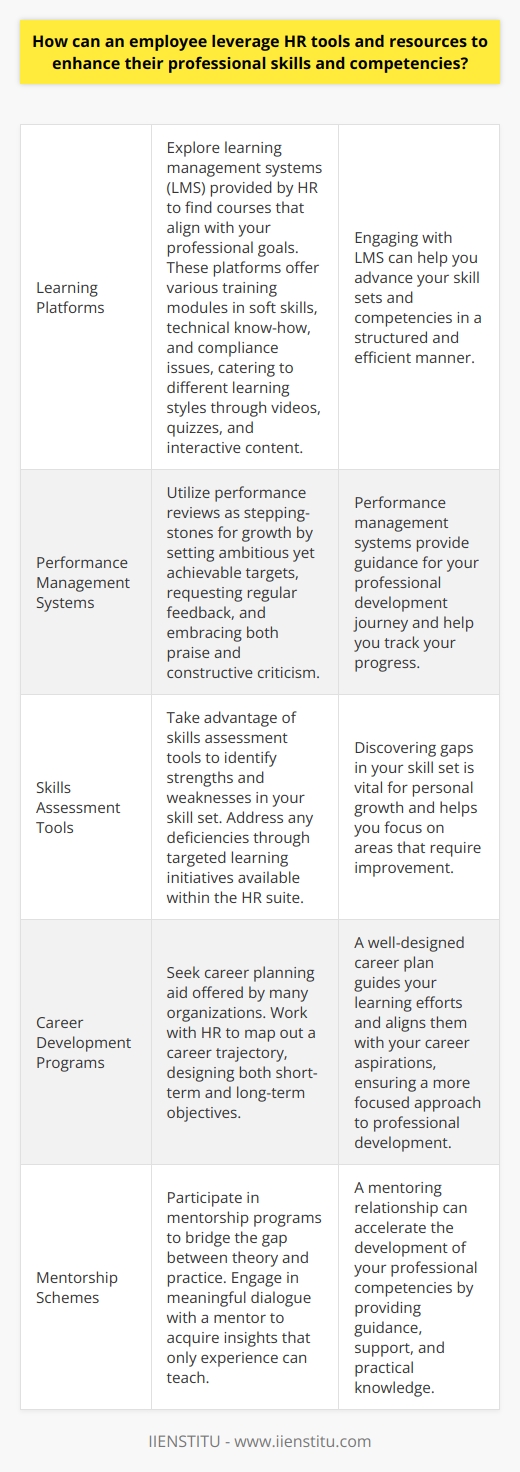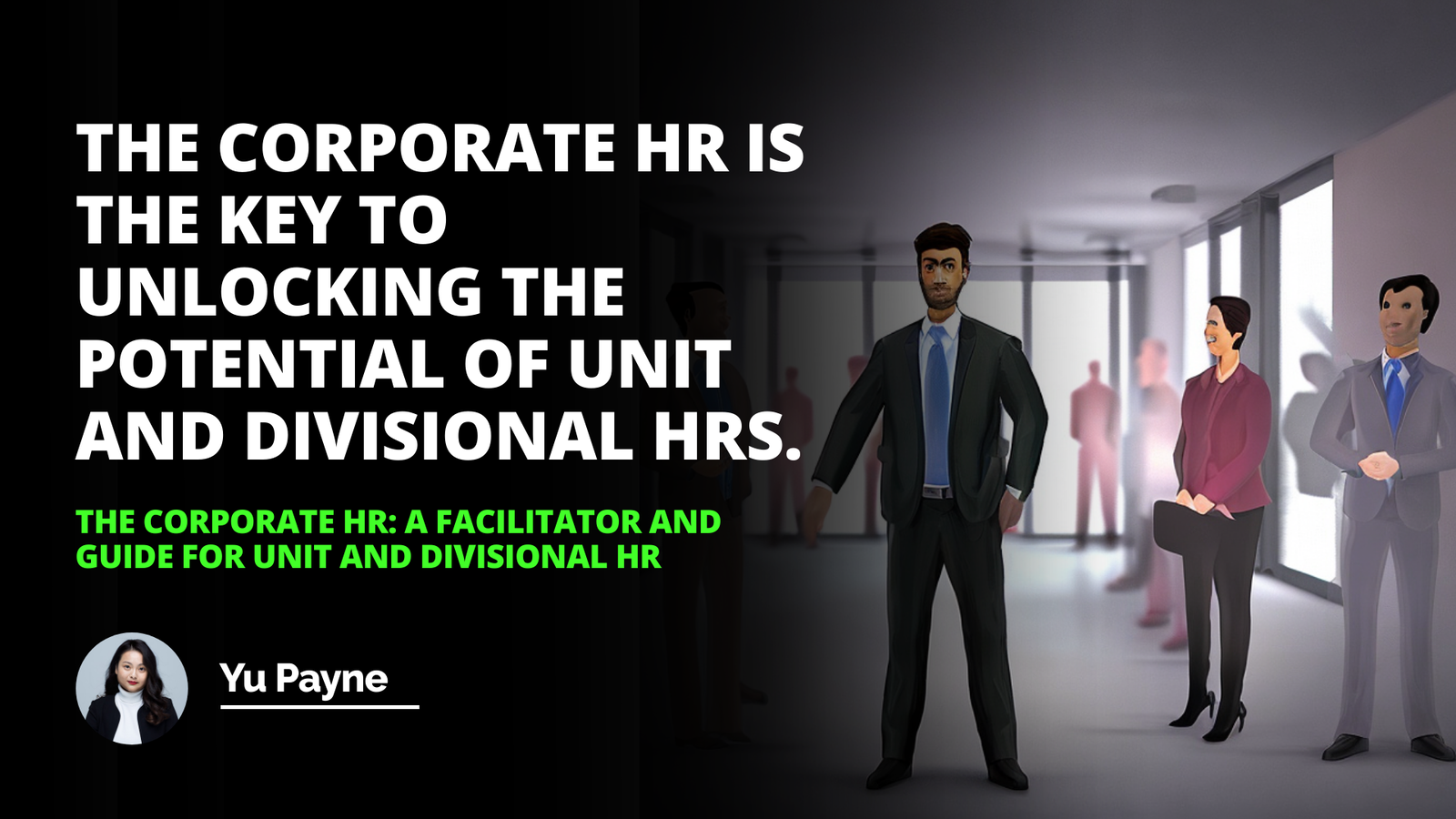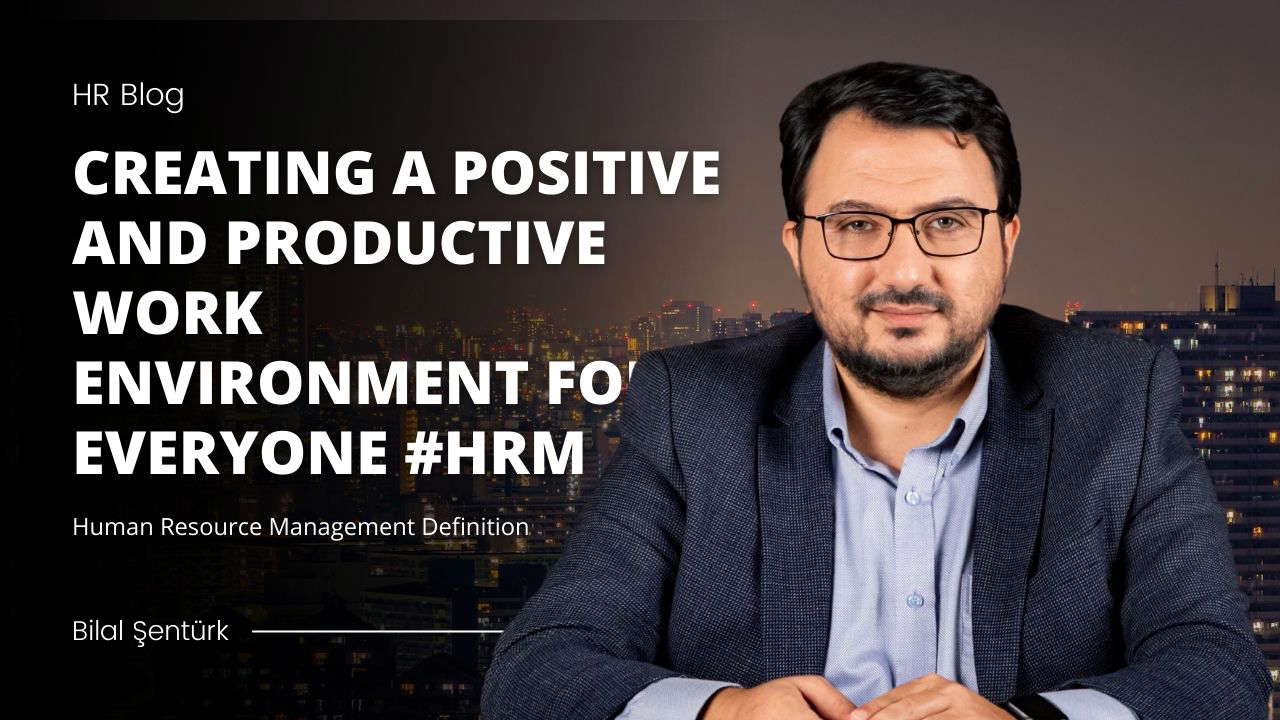
In the swiftly evolving landscape of today’s business world, human resource departments play a pivotal role in shaping the growth and development of their workforce. Employee career development has emerged as a critical pillar of HR strategy, ensuring that individuals are equipped with the necessary skills and competencies to drive both personal and organizational success. Delving into the intricacies of this concept reveals a multifaceted approach that includes planning, training, and performance management.
This blog aims to dissect these components and provide actionable strategies to ensure a robust and successful HR employee career development program. By harnessing a comprehensive knowledge and expertise in the field, we will explore how organizations can cultivate a workforce that is not only proficient but also highly motivated and engaged in their career progression.
Understanding the Role of HR in Employee Career Development
Defining Employability: Employability is a term that captures an individual's appeal in the labor market, based on their ability to gain initial employment, maintain employment, and obtain new employment if required. Understanding employability involves recognizing that it is not static; it evolves as economic conditions, technology, and job roles change.
For both the employee and the employer, employability hinges on a complex blend of knowledge, skills, personal attributes, and the ability to navigate through the labor market. Remaining employable is indispensable for the workforce as it assures job security and career progression, while for employers, it ensures a skilled and adaptable team ready to meet the company's strategic objectives.
The Duty of HR in Promoting Employability
HR departments carry a significant duty in promoting employability by actively encouraging an environment of continuous learning and improvement. They are responsible for identifying employees' potential for growth and guiding them towards self-development. Human resources courses play a crucial role in empowering HR professionals with the insights and tools needed to create effective development strategies.
HR can offer career paths, mentorship, and coaching that help identify and enhance the skills of their employees, thus fostering an environment of career growth and development. Moreover, by providing relevant and strategic online courses, workshops, and seminars, HR departments can directly impact the employability of their workforce, ensuring that they remain competitive and contributory in an ever-changing business environment.
Providing real-world examples of HR promoting career development
Companies that excel in facilitating employee career development are often those that embed HR strategies into their organizational fabric. For instance, Google has become synonymous with its robust career development programs, largely credited to their 'Googler-to-Googler' network which promotes peer-to-peer learning.
Additionally, other corporations often establish leadership development programs aimed at nurturing high-potential employees through a combination of rotational assignments, formal training, and mentoring. These examples showcase the integral role of HR in crafting pathways for workforce development that align employee aspirations with business needs.
Key Components of an Effective HR Employee Career Development Program
Career Planning
A well-defined career plan serves as the backbone of employment growth, allowing individuals to chart a course for achieving their career objectives. It involves understanding one’s strengths, weaknesses, interests, and values, and aligning them with opportunities and trends in the marketplace.
HR’s role in facilitating career planning is to provide the frameworks and support necessary for employees to construct their career vision and identify the steps needed to get there. This could involve one-on-one career coaching sessions, career mapping exercises, and setting achievable, time-bound objectives that keep employees focused and motivated.
Training and Development
For career development to be dynamic and effective, it is imperative to establish an ecosystem where skill acquisition and upgrading are deeply ingrained. Here comes the significant role of HR in identifying the skill gaps within the organization and providing ample training opportunities to close these gaps.
İnterview Questions On Balancing Work And Personal Time Effectively
How Time Management Strategies Have Evolved For Job İnterview
Investing in online courses, certifications, and development programs helps ensure that the workforce stays relevant and capable. HR professionals can thereby foster a culture of lifelong learning, which in turn cultivates highly capable employees prepared to take on new challenges and responsibilities with ease.
Performance Management
Performance management is another essential component to ensure that employees not only strive to improve their skills but are also recognized for their efforts and outcomes. Understanding the link between individual performance and career growth incentivizes employees to maintain high productivity and quality in their work.
HR holds the responsibility for implementing fair and transparent performance appraisal systems, which are pivotal for identifying high performers, providing constructive feedback, and setting new targets. It also encompasses succession planning to prepare promising employees for future leadership roles within the company.
Illustrating successful HR career development program components through examples
Looking at successful HR career development programs, one notes how companies like Deloitte have implemented a 'corporate lattice' model that allows for non-linear career progression. Their approach emphasizes customized career paths, emphasizing the value of varied experiences and unconventional role changes.
Similarly, IBM’s robust learning and development platforms ensure that employees are not only continuously learning but are also recognized for their new skills, which translates into career growth opportunities. These examples showcase HR’s impact on fostering a learning culture and structuring performance assessments that genuinely contribute to the value and sustainability of an employee's career trajectory.
Addressing Common Obstacles in HR Employee Career Development
Various impediments can disrupt the smooth functioning of HR employee career development programs. A prevalent issue includes a lack of engagement and motivation among employees, which could stem from unclear career advancement opportunities or a perceived lack of support from the organization. This calls for HR to take proactive measures in consistently communicating the potential career paths and recognizing achievements in meaningful ways.
Limited resources for training and development pose another significant challenge. Even with the best intentions, the scarcity of funds or time can bottleneck the implementation of comprehensive training programs. In such situations, leveraging cost-effective online courses and creating in-house training modules using the expertise of existing staff can be highly beneficial.
Lastly, the complexity of performance assessment and feedback can deter the effectiveness of career development efforts. HR professionals must adopt an empathetic and constructive approach in providing feedback, ensuring it is timely and specific. Additionally, providing clear criteria and measurement tools for gauging performance fosters a transparent atmosphere where employees understand what is expected of them.
By addressing these obstacles with pragmatic solutions, HR can establish a more nurturing environment for career development that resonates equally with employer expectations and employee ambitions.
Conclusion
To encapsulate, HR employee career development is a multifaceted and strategic endeavor requiring commitment, resources, and perpetual innovation from human resource departments. Such development programs, when executed effectively, not only bolster the individual's career prospects but also amplify the organization's prowess in the corporate landscape.
The integration of career planning, training and development, and performance management are indispensable in cultivating a workforce that is competent, engaged, and well-prepared for the future.
As HR continues to navigate through the challenges and adjusts its strategies to the dynamic work environment, one can anticipate a constant evolution of career development practices. Ultimately, the harmonization of employee aspirations and organizational goals will be the benchmark of success for any HR-led career development initiative.
Frequently Asked Questions
What are some key strategies for successful career development in the HR field?
Understanding Career Development in HR
Continual Learning is Essential
Continual learning stands paramount in HR. HR professionals must keep pace with evolving laws. Regulations change; thus, knowledge updates prove non-negotiable. Best practices in diversity, equity, and inclusion require mastery. Technological proficiencies also enhance HR effectiveness.
Networking Opens Doors
Networking serves as a powerful tool. Connections can offer new opportunities and insights. They also provide mentorship and helpful resources. Industry conferences and professional groups encourage networking. Engaging on platforms like LinkedIn aids in relationship-building.
Specialization Can Set You Apart
Specialization often leads to competitive advantage. Choose areas like recruitment, training, or compensation. Deep expertise in a niche attracts employers. It offers higher value to your organization.
Practical Experience is Invaluable
Seek hands-on experience. It could be through internships or HR roles. Volunteer for projects to gain varied skills. Understand different aspects of the HR function. Smaller companies might offer broader experience faster.
Certification Boosts Credibility
Official certifications enhance professional credibility. Consider SHRM, HRCI or relevant local certifications. They signal commitment to the field. Certifications might be advantageous for career progression.
Soft Skills Should Not Be Overlooked
HR hinges on effective interpersonal skills. Communication, empathy, and conflict resolution are critical. These skills foster a positive workplace environment. HR professionals lead by example in soft skills.
Stay Updated with HR Technologies
Technological proficiency cannot be overstated. Familiarize oneself with HR Information Systems (HRIS). Understand how to maximize big data analytics. Stay up to date with trends like AI in HR. Adaptability to new technologies is key.
Aim for Strategic HR Leadership
Understand business strategy. Align HR practices with organizational goals. HR should influence business decisions. Strategic thinking in HR promotes internal growth.
Reflect and Adapt
Regular self-assessment aids career growth. Reflect on career goals and achievements. Seek feedback and use it for improvement. Adapt to new challenges and roles. Resilience helps overcome career setbacks.
Ethical Practice is Non-Negotiable
Ethical practice in HR upholds organizational integrity. Adhere to confidentiality and fair practice. Ethical issues in HR can have long-term impacts. Integrity attracts trust and respect in any role.
Summing Up the Strategy
Successful HR career development balances many aspects. Combining technical knowledge with soft skills works best. Continual development, networking, and ethical practice lay the foundation. Specialization, certification, and strategic insight lead to advancement. Adaptability and reflection ensure longevity in the ever-changing HR landscape.
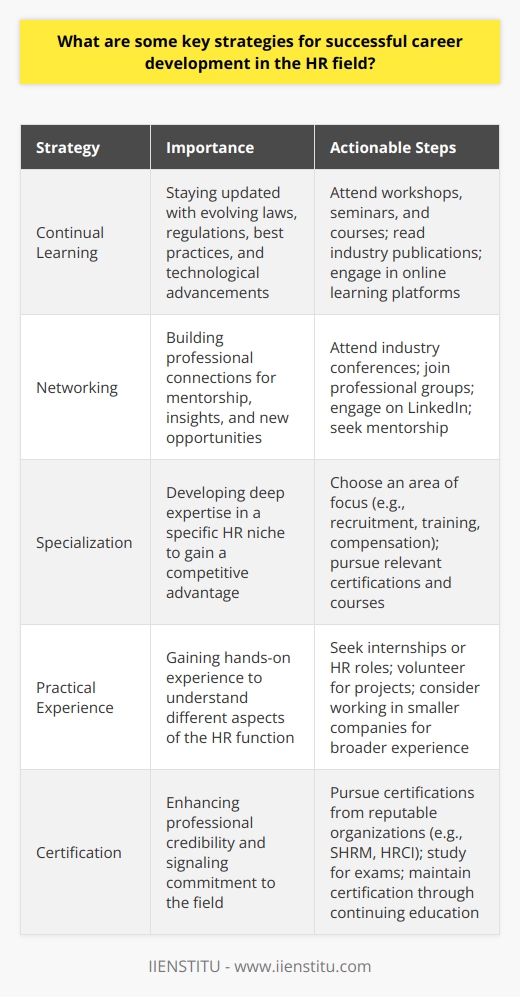
How can HR professionals effectively cultivate a growth mindset for long-term career advancement?
Cultivating a Growth Mindset
Understand the Growth Mindset
To foster a growth mindset, HR professionals must first understand it. It hinges on the belief that abilities can develop. This contrasts with a fixed mindset, where individuals see abilities as static. HR professionals should believe in their capacity to grow. This positivity influences their approach to learning and adversity.
Embrace Challenges
Challenges become opportunities for HR professionals. They must not shy away. Instead, they should engage with these experiences. Each challenge provides a chance to learn. It also tests and expands their capabilities.
Persist in the Face of Setbacks
Setbacks form part of any career trajectory. HR professionals must persist. They should view failures as learning points. This perspective helps them advance in their careers. Each hurdle crossed builds resilience. It also reinforces a commitment to growth.
Effort as a Path to Mastery
Hard work is key. HR professionals must see effort as essential. It is the path to mastering new skills. They should commit to continuous learning. Both formal and informal education are critical. A sustained effort ensures they remain relevant. It also prepares them for future roles.
Learn from Criticism
Feedback is crucial. HR professionals should seek and value it. Constructive criticism aids professional development. It fuels improvement and innovation. They should not fear it. Instead, they must use it to build strength in areas of weakness.
Find Lessons in the Success of Others
Success is not zero-sum. HR professionals should celebrate others' achievements. They can learn from peers. This includes strategies that lead to success. It also helps them forge a collaborative spirit. Networks they build in this way can be supportive and enriching.
Apply Strategies for Fostering Growth
Strategic actions are necessary. To foster a growth mindset, HR professionals can:
Set achievable goals
Reflect on their learning
Engage in developmental activities
Find mentors and be mentors
Network with professionals who embody growth mindsets
Implement Practices in Daily Work
Daily testament to a growth mindset matters. HR professionals should:
Demonstrate flexibility
Show willingness to change
Act on feedback received
Prioritize employee development
Lead by Example
HR professionals must model behaviors. They influence organizational culture. By exemplifying a growth mindset, they set a standard. Others in the organization will follow their lead.
HR professionals play critical roles. They serve as catalysts for change. Cultivating a growth mindset lays the foundation for success. It ensures their own career advancement. It also drives the development of all employees. Such an environment will foster innovation. It leads to sustainable growth within an organization. A growth mindset is not an option but a necessity. Let HR leaders embrace this truth. Their future, and that of their colleagues, depends on it.
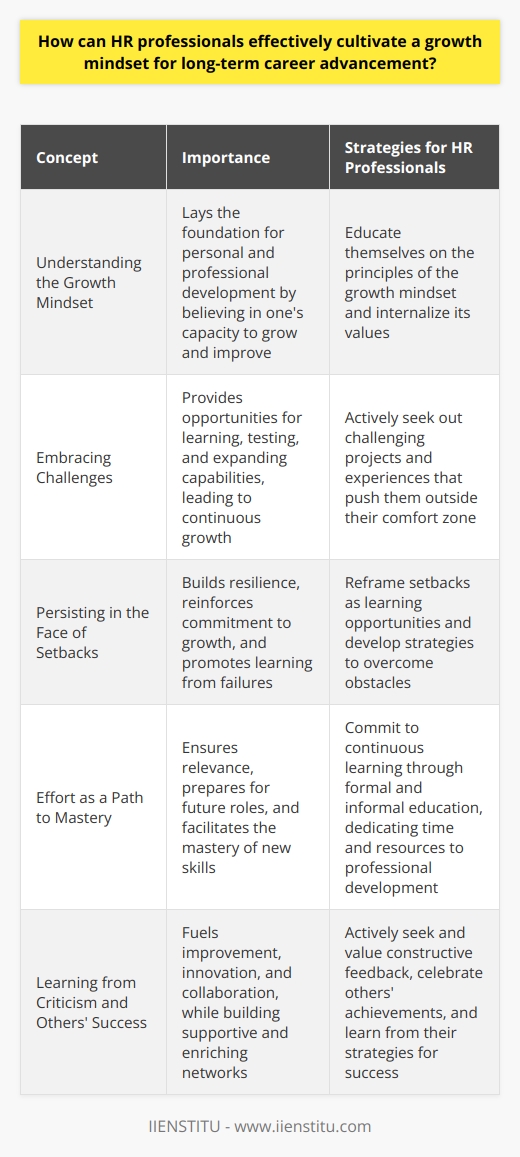
How can an employee leverage HR tools and resources to enhance their professional skills and competencies?
Evaluating HR Tools and Resources
Employees often overlook the wealth of opportunities that HR tools and resources offer for professional growth. These instruments not only assist in daily tasks but also in advancing skill sets and competencies.
Identify Learning Platforms
Most HR departments provide access to learning management systems (LMS). Explore them. Find courses that align with your goals. These platforms host various training modules: soft skills, technical know-how, compliance issues. They cater to diverse learning styles with videos, quizzes, and interactive content.
Engage in Performance Management Systems
Performance reviews are not mere formalities. They are stepping-stones for growth. Use them. Set ambitious yet achievable targets. Request feedback regularly. Embrace both praise and constructive criticism. They guide your professional development journey.
Utilize Skills Assessment Tools
Discovering gaps in your skill set is vital. Skills assessment tools serve this purpose. Take the tests. Identify strengths, recognize weaknesses. Address any deficiencies through targeted learning initiatives available within the HR suite.
Leverage Career Development Programs
Many organizations offer career planning aid. Seek such programs. Together with HR, map out a career trajectory. Design both short-term and long-term objectives. This plan guides your learning efforts, aligning them with your career aspirations.
Participate in Mentorship Schemes
Mentorship programs bridge the gap between theory and practice. Find a mentor. Engage in meaningful dialogue. Acquire insights that only experience can teach. This relationship can accelerate the development of your professional competencies.
Exploit Internal Communication Channels
Communication tools foster collaboration and knowledge-sharing. Join the dialogue. Learn from peers. Share experiences. Engage with cross-functional teams. This develops your interpersonal skills and expands your understanding of the business.
Attend Workshops and Seminars
HR often hosts in-person training sessions. Attend these sessions. They provide a chance to develop new skills in an interactive environment. They also allow for networking, which can open new paths for development and career progression.
Access Digital Libraries and Resources
Many HR departments curate repositories of digital books, articles, and podcasts. Dive in. These resources are invaluable for continuous learning. They keep you updated on industry trends, innovative practices, and emerging theories.
Use Feedback Tools
Regular feedback fosters continuous improvement. Tools like 360-degree feedback systems offer comprehensive insights. Act on this feedback. Identify areas for enhancement. Develop action plans to improve.
Participate in Competency Frameworks
Understanding the competencies required for success in your role is crucial. Study the frameworks. They provide clear guidelines for the skills and behaviors your organization values. Align your personal development plan accordingly.
HR tools and resources are pivotal for professional development. Employees must embrace and leverage the full spectrum to enhance their skills and competencies. This proactive approach can lead to improved job performance, job satisfaction, and ultimately, a well-fledged career.
